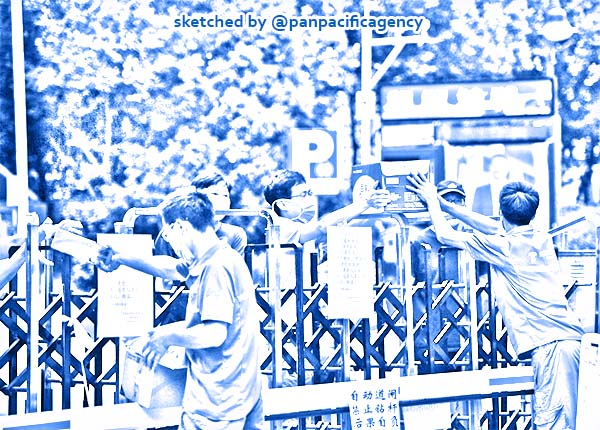Shanghai’s subway and shops reopen and streets fill up after two-month lockdown

Delivery workers hand parcels to people in a residential compound in Beijing's Xicheng district on Wednesday. Restrictions on access to all communities have resumed as the city increased the level of its COVID-19 emergency response. CHEN ZHONGHAO/XINHUA. Sketched by the Pan Pacific Agency.
SHANGHAI, Jun 1, 2022, The Guardian. Shanghai has eased a range of Covid-19 restrictions in a step towards returning to normal after a two-month lockdown that confined residents of the megacity to their homes and battered China’s economy, The Guardian reported.
The commercial hub of 25 million people was closed down in sections from late March, when the Omicron virus variant fuelled China’s worst outbreak since Covid first took hold in 2020.
After some rules were gradually relaxed over the past few weeks, authorities on Wednesday began allowing people in areas deemed low-risk to move around the city freely. Factories and businesses were set to restart work after being dormant for weeks.
“This is a moment that we have been looking forward to for a long time,” the Shanghai municipal government said in a statement on social media. “Because of the impact of the epidemic, Shanghai, a megacity, entered an unprecedented period of silence.”
On Wednesday morning, people were seen travelling on Shanghai’s subway and heading to office buildings, while some shops were preparing to open. On the streets, people took photos of themselves out and about.
Shanghai residents spoke of their relief at the relaxation of restrictions. One 20-year-old who declined to give his name said his community let off fireworks at midnight and that it “feels like Chinese New Year”.
Another said she was happy to reconnect with friends offline and had celebrated with a picnic on the Bund. “A few friends and I had a picnic… played music, drank, chatted, watching people coming and going on both sides of the Huangpu River.”
Others expressed relief, tinged with fear that lockdowns could return.
A 27-year-old who only gave her name as Wang, said: “I am a little anxious about the future situation in both work and life. But emotionally, it’s a lot easier than the time in lockdown. I told my boss that I’m leaving [China] if the city is locked down again.”
A day earlier, bright yellow barriers that had hemmed in buildings and city blocks for weeks were taken down in many areas.
The restrictions had hammered the economy of the city, snarling supply chains in China and abroad, and causing resentment among residents.
Deputy mayor Zong Ming told reporters on Tuesday that the easing would affect about 22 million people.
Malls, convenience stores, pharmacies and beauty salons will be allowed to operate at 75% capacity, while parks and other scenic spots will gradually reopen.
But cinemas and gyms remain closed, and schools – shut since mid-March – will slowly reopen on a voluntary basis. Buses, subway and ferry services will also resume, transport officials have said.
Taxi services and private cars will be allowed in low-risk areas, permitting people to visit friends and family outside their district. But the city government warned that the situation was not yet normal.
“At present, there is still no room for relaxation in consolidating the achievements of epidemic prevention and control,” it said.
China has persisted with a zero-Covid strategy, which involves rapid lockdowns, mass testing and long quarantines to try to completely eliminate infections.
But the economic costs of that policy have mounted, and the Shanghai government said that “the task of accelerating economic and social recovery is becoming increasingly urgent”.
E-commerce worker Chen Ying said ahead of the easing that she still planned to work from home but might treat her two-year-old son to a long-awaited walk outside.
“We should have been free to begin with, so don’t expect me to be deeply grateful now they’ve given it back to us,” she told AFP.
With Agence France-Presse